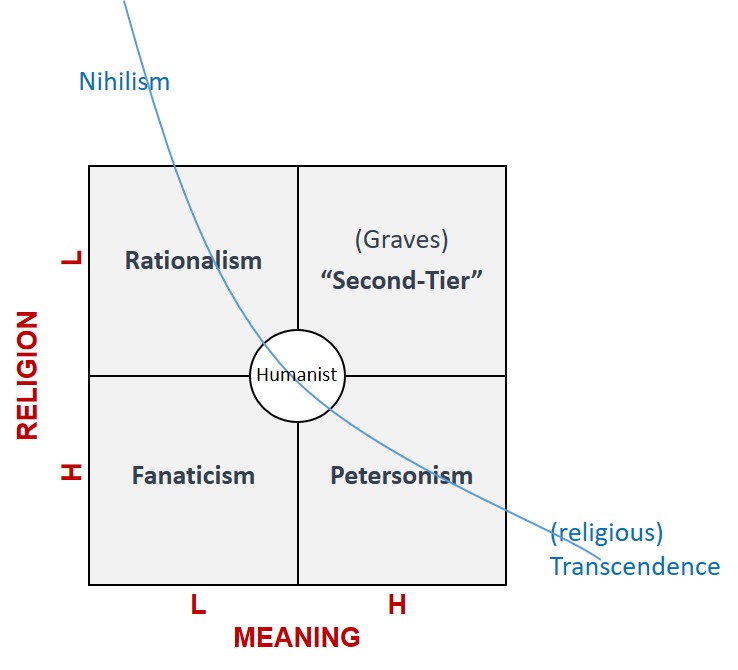
Jordan Peterson turns out to be yet another 2D, cardboard cut-out ‘thought-leader’. It took me a while to work out what his two dimensions were, but I unravelled the not-so-mysterious mystery sitting on a plane this week. I know early on that ‘meaning’ was one of the dimensions. That one was easy because I believe my ‘meaning’ radar has been very sensitively tuned since I started reading Edward Matchett’s work. Plus, there’s a whole rule in Peterson’s 12 Rules For Life (7: Pursue What Is Meaningful (Not What Is Expedient)) devoted to the topic. It took me a while, though, to work out his second dimension. Or maybe I was hoping to discover it wasn’t what my initial impressions feared it might be. At first, I thought it was just an annoying feature of 12 Rules For Life. Peterson’s argument building formula. Which seems to go something like this:
1) Assert a hypothesis
2) Illustrate it with a compelling case study or two
3) Make a usually decent stab of describing the surrounding science – usually human psychology- or physiology- based.
4) Quote the Bible
5) QED the point is proven
The contrast between steps three and four being the annoying bit. I have no problem with Peterson – or anyone for that matter – believing in fictional deities, but when they lay their beliefs side by side on equal terms with the accumulated mass of scientific data as if they’re comparing like-with-like it betrays all the tenets of scientific research. And specifically the awkward evidence and proof related bits. Faith can be a wonderful thing, but it can never be proof.
Anyway, that’s none of my business. What is my business is now realising that Peterson is nothing more nor less than a fire-breathing religious preacher, and that religion is his second dimension.
As soon as I had that insight, I was able to draw this 2×2 matrix:

Peterson’s two-dimensional thinking fallacy is all about believing the blue dotted line is a spectrum that people must sit somewhere along. At one end of the spectrum is a person that has zero religious life and zero meaning. The nihilist. At the other is someone who devotes their life to religion and religious study and therefore leads a highly meaningful life. The heart of the fallacy is the word ‘therefore’, since Peterson sees meaning and religion as unbreakably tied. In his terms it is only possible to live a meaningful life if you are religious. By which he specifically means ‘believe in God and study the Bible’. Followers of Peterson are encouraged to live their lives in the bottom right-hand quadrant of the Matrix. There seem to be so many of thee people these days that we can probably safely label the box, ‘Petersonism’.
The whole point of drawing the 2×2 matrices, however, is to make the point that the world always allows for a third dimension, and that – if we’re smart and creative – we’re able to leave the cardboard cut-out 2D world, solve the contradiction and enter the best-of-both-worlds third dimension described by the top-right-hand box. Meaning and religion are, in other words, correlated but not causally. It is perfectly possible – if we think hard and seek to design a better way – to leave a highly meaningful life in the complete absence of religion, God or the Bible. Something a group of far more effective psychology scholars, building on the work of Clare Graves, called ‘second tier’ thinking.
All Peterson is doing in his angry-foghorn rants is encouraging people to move from one end of the spectrum he wrongly (or duplicitously) assumes is fundamental. He’s one of a number of phenomena happening in the world right now that are doing nothing more nor less than inducing a societal pendulum to start shifting back in the direction it came from. About six hundred years ago.
Humans are better than that. The most powerful human trait – the thing that makes us stand out relative to any other living form on the planet – is our ability to design our future. Which is not the same thing at all as seeing the problems of today and in effect saying, look how much better it was yesterday, we all need to go back there. Anyone that understands complex adaptive systems (something Peterson claims to do) knows that you can never step in the same river twice. There is no such thing as ‘going back’ in a complex system. There is only thinking hard, trying things out and – here’s where I absolutely agree with Peterson – have an intention to make our lives of inevitable suffering just that little bit better. One day at a time we have the ability to design a better future for ourselves and – more importantly – for those around us. But to do so we have to put away foolish things. And top of that foolish-things list is the fallacious ‘either/or’ thinking Peterson seems unable or unwilling to escape.

Hi Darrell! Wouldnt Peterson claim the third dimension is “adopting responsibility”?
Hi Peter, I’m not sure. He might see it as a ‘third dimension’, but I think the reality is he’s merely swinging the same rights-responsibilities pendulum back in the other direction. The real third-dimension involves solving the contradiction to get the best of both worlds, and I think that’s what Clare Graves ‘Second Tier’ thinking is all about.
Hi Darrell. I’m not familiar with Second tier, and you are probably right. It was quite interesting in the debate with Sam Harris he answered the question “do you believe God exists?” with ” I don’t know but I act as though he does”. I think Harris compared that way of handling truth to the rule of always treating a gun as if it is loaded (not pointing at people etc.) even if you know for certain it is not. The ones who do not, end up shooting themselves or someone else by mistake..